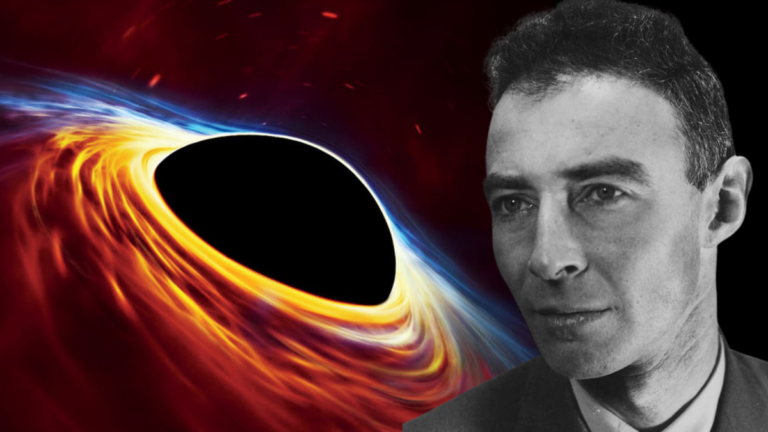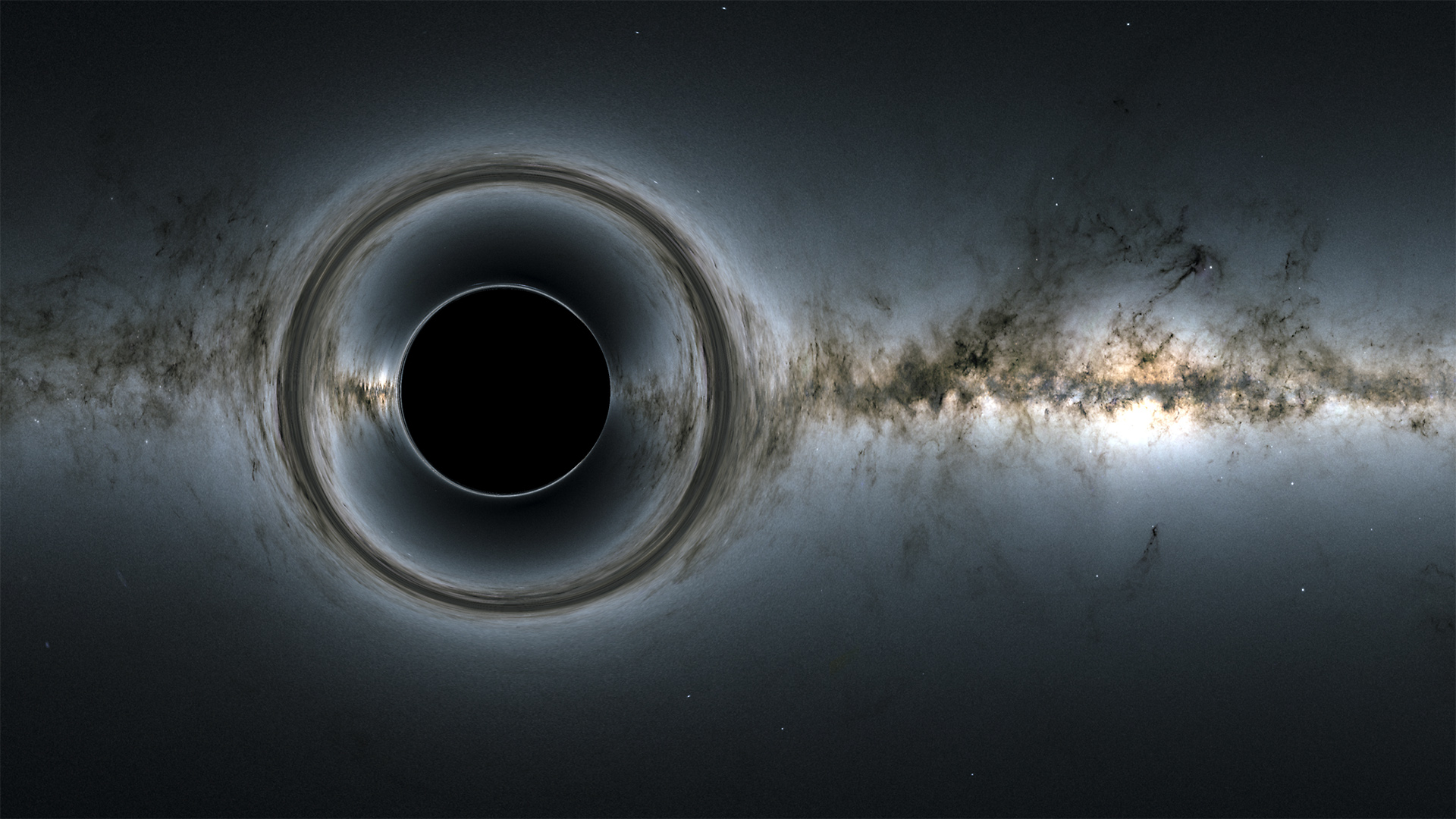
[ad_1]
Before becoming “the father of the atom bomb,” J. Robert Oppenheimer made a significant contribution to the science of black holes.
Oppenheimer will forever, for better or for worse, be associated with the incredible destructive power of the atomic bomb and the image of the mushroom cloud, a near-Biblical symbol of destruction. That association will only strengthen in the public eye with today’s (July 21) release of “Oppenheimer,” Christopher Nolan’s highly anticipated biopic about the physicist.
But before journeying to Los Alamos, New Mexico, in 1942 to contribute to the development of the atomic bomb, Oppenheimer was a theoretical physicist focusing on quantum physics.
In 1939, he and his University of California, Berkeley colleague Hartland S. Snyder published a pioneering paper entitled “On Continued Gravitational Contraction,” which used the equations of Albert Einstein’s theory of gravity, general relativity, to show how black holes could be born.
“Oppenheimer proposed the very first collapse model to describe how a star could collapse into a black hole,” Xavier Calmet, a professor of physics at the University of Sussex in England, told Space.com. “This model explains the formation of black holes as a dynamical astrophysical process, the final stage of the evolution of heavy-enough stars. This model is still being used today.”
Related: ‘Oppenheimer’ trailer reveals Cillian Murphy as Manhattan Project’s genius bomb maker
Calmet said that he recently used the model himself, in a paper describing the collapse of black holes when considering quantum gravity.
“This model is very significant because it is analytically solvable — solving the equations can be done with pen and paper and does not require numerical work. All the physics is thus easily trackable,” he said. “Yet, despite its simplicity and maybe even crudeness, it is complex enough to describe many of the features of a collapsing star.”
Ironically, as Oppenheimer and Snyder worked on the paper, which so heavily depended on the 1915 theory of general relativity, the father of that theory, Einsten, was himself completing research aimed at showing that black holes could not exist.
History would show Oppenheimer to be right about black holes, of course.
Related: Albert Einstein: His life, theories and impact on science
Oppenheimer pushes the limit
Eight years before Oppenheimer’s theory of star collapse and black hole birth, another theoretical physicist was thinking about what happens when stars run out of fuel for nuclear fusion.
When this fuel is exhausted, a star can no longer support itself against gravitational collapse. While the star’s outer layers are shed, its core rapidly contracts, leaving an exotic stellar remnant. The nature of the remnant depends on the mass of the stellar core.
Indian-American physicist Subrahmanyan Chandrasekhar realized that, for stellar cores with a mass less than 1.4 times that of the sun, gravitational collapse would halt due to quantum effects that prevent particles from “squashing” too close together.
This would come to be known as the Chandrasekhar limit, and any star below it — unless it has a stellar companion feeding it material — is doomed to end its existence as a smoldering stellar remnant called a white dwarf. That will be the fate of our star, the sun, after it exhausts the hydrogen at its core in around 5 billion years.
Related: When will the sun die?
For stellar cores at least 1.4 times more massive than the sun, there is enough pressure, and thus heat, generated during gravitational collapse that further bouts of nuclear fusion can be triggered, with the helium created by the fusion of hydrogen itself forging heavier elements like nitrogen, oxygen and carbon.
The most massive stars undergo a series of these collapses and bouts of nuclear fusion. But Oppenheimer and his students wanted to know where this gravitational collapse path leads and, thus, what is the final state of the universe’s biggest stars.
This answer had already been delivered by a German physicist in 1916. Oppenheimer just had to find out how to get there.
The two births of black holes
In 1915, while serving on the front with the German army during the First World War, astronomer Karl Schwarzschild got his hands on a copy of Einstein’s theory of general relativity. Astoundingly, and to the shock of Einstein, under these incredibly harsh conditions, Schwarzschild managed to calculate an exact mathematical solution to the field equations of general relativity.
In these solutions lurked two disturbing things — places known as “singularities” where physics as we know it completely breaks down. These singularities indicated the existence of objects with gravity so intense that they could “swallow” light.
One of the singularities was deemed a coordinate singularity, which could be removed with a little clever mathematical manipulation. This coordinate singularity would come to be known as the Schwarzschild radius — the point at which the gravity of a body becomes so great that the velocity needed to escape its clutches is greater than the speed of light.
This one-way light-trapping surface is called the “event horizon,” and it represents the outer boundary of the black hole.

The other singularity, the true or gravitational singularity, could not be dealt with mathematically. Nothing could remove it, so it was, and still is, the point at which physics completely breaks down — the heart of the black hole.
That was the theoretical birth of the black hole concept, but it didn’t say anything about the creation of these cosmic titans — just that they can exist.
While Einstein toiled in 1939 to destroy this gravitational singularity, and thus the concept of the black hole, Oppenheimer was delving into how such objects could come to exist.
Working with simple assumptions that neglect quantum effects and don’t consider rotation, Oppenheimer set Snyder to work. And this paid off when the latter researcher discovered that what appears to happen to a collapsing star is dependent on an observer’s point of view.
Snyder theorized that, at some distance from the collapsing star, light from a source close to the event horizon would have its wavelength stretched by gravity, a process called redshift, with it becoming ever more red.
At the same time, the frequency of this light is being reduced from the observer’s perspective. This frequency reduction continues until, for the distant observer, the light is effectively “frozen.”
Oppenheimer and collaborators realized the story is quite different for an observer unfortunate enough to be falling with the surface of the collapsing star. An observer in this position would fall beyond the event horizon without noticing anything significant about it.
Of course, in reality, an observer would be “spaghettified” by intense tidal forces caused by the difference in the gravitational pull on their upper and lower body. This would kill them before they hit the event horizon, at least for smaller black holes, in which the Schwarzschild radius is close to the gravitational singularity.
This concept was initially referred to as a “frozen star” due to the apparent freezing of light at the event horizon. It wouldn’t receive its more familiar and snappier name until 1967, when Princeton University physicist John Wheeler coined the term “black hole” during a lecture.
Oppenheimer and colleagues may have taken a different path than Schwarzschild, but still, the two teams of physicists arrived at the same destination: the concept of a stellar body so massive that its gravity traps light and causes infinite redshift. Schwarzschild had the theory, but Oppenheimer and colleagues were the first scientists who truly understood the physical birth of a black hole.
Three years later, Oppenheimer would travel to Los Alamos, cementing his place in history and in the perception of the public. But many, scientists especially, remember him as the father of black holes.
“Oppenheimer made very significant contributions to black hole physics and physics as a whole,” Calmet concluded. “While the general public may associate his name with the bomb and the Manhattan Project, his contributions to physics and astrophysics are well appreciated by the scientific community.
“He was one of the leading physicists during his lifetime and was extremely influential, and his seminal work is still relevant today.”
[ad_2]